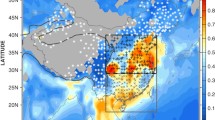Abstract
By analysis of observation data, this paper demonstrates that pollution particles could reduce surface wind speed through blocking solar radiation to the ground. The comparation between temperature at the lowland meteorological station Xi’an and that over the nearby highland station Mt. Hua suggests that surface solar radiation at Xi’an is reduced due to the increasing anthropogenic aerosols. The reduced surface energy suppresses the atmospheric instability and convective flows, and thus the downward transfer of faster winds aloft is reduced. Consequently, wind speeds near surface are weakened. This reduction of surface winds is shown by the significant reverse trends of wind speeds over the two stations at different elevations. The aerosols’ effects on winds are also manifested in the trends of radionsonde wind speed. The decreased surface winds in Xi’an have also reduced local pan evaporation.
Similar content being viewed by others
References
Arnfield, A. J., 2003: Two decades of urban climate research: a review of turbulence, exchanges of energy and water, and the urban heat island. Int. J. Climatol., 23, 1–26, doi:10.1002/joc.1859.
Che, H. Z., G. Y. Shi, X. Y. Zhang, et al., 2005: Analysis of 40 years of solar radiation data from China during 1961–2000. Geophys. Res. Lett., 32, L06803, doi: 06810.01029/02004GL022322.
Forster, P., V. Ramaswamy, P. Artaxo, et al., 2007: Changes in atmospheric constituents and in radiative forcing. Climate Change 2007: The Physical Science Basis, S. Solomon, et al., Eds., Cambridge University Press.
Huang, L., J. Li, D. Zhao, et al., 2008: A fieldwork study on the diurnal changes of urban microclimate in four types of ground cover and urban heat island of Nanjing, China. Building and Environment, 43, 7, doi:10.1016/j.buildenv.2006.1011.1025.
Jacobson, M. Z., and Y. J. Kaufman, 2006: Wind reduction by aerosol particles. Geophys. Res. Lett., 33, L24814, doi: 24810.21029/22006GL027838.
Karl, T. R., P. D. Jones, R. W. Knight, et al., 1993: A new perspective on recent global warming: Asymmetric trends of daily maximum and minimum temperature. Bull. Amer. Meteor. Soc., 74, 1007–1023, doi:1010.1175/1520-0477(1993)1074<1007:ANPORG>1002.1000.CO;1002.
Koren, I., Y. J. Kaufman, L. A. Remer, et al., 2004: Measurement of the effect of amazon smoke on inhibition of cloud formation. Science, 303, 1342–1345, doi: 1310.1126/science.1089424.
Perlwitz, J., I. Tegen, and R. L. Miller, 2001: Interactive soil dust aerosol model in the GISS GCM 1. Sensitivity of the soil dust cycle to radiative properties of soil dust aerosols. J. Geophys. Res., 106, 118167–118192.
Pilewskie, P., 2007: Climate change: Aerosols heat up. Nature, 448, 541, doi: 510.1038/448541a.
Qian, Y., D. P. Kaiser, L. R. Leung, et al., 2006: More frequent cloud-free sky and less surface solar radiation in China from 1955 to 2000. Geophys. Res. Lett., 33, L01812, doi: 01810.01029/02005GL024586.
Ramanathan, V., P. J. Crutzen, J. T. Kiehl, et al., 2001: Aerosols, climate, and the hydrological cycle. Science, 294, 2119–2124, doi: 2110.1126/science.1064034.
—, F. Li, M. V. Ramana, et al., 2007: Atmospheric brown clouds: Hemispherical and regional variations in long-range transport, absorption, and radiative forcing. J. Geophys. Res., 112, doi: 10.1029/2006JD008124.
Rayner, D. P., 2007: Wind run changes: The dominant factor affecting pan evaporation trends in Australia. J. Climate, 20, 3379–3394, doi: 3310.1175/JCLI4181.3371.
Roderick, M. L., L. D. Rotstayn, G. D. Farquhar, et al., 2007: On the attribution of changing pan evaporation. Geophys. Res. Lett., 34, L17403, doi: 10.1029/2007GL031166.
Rosenfeld, D., 2000: Suppression of rain and snow by urban and industrial air pollution. Science, 287, 1793–1796, doi: 1710.1126/science.1287.5459.1793.
—, 2006: ATMOSPHERE: Aerosols, clouds, and climate. Science, 312, 1323–1324, doi: 10.1126/science.1128972.
Sarrat, C., A. Lemonsu, V. Masson, et al., 2006: Impact of urban heat island on regional atmospheric pollution. Atmospheric Environment, 40, 1743.
Shenbin, C., L. Yunfeng, and A. Thomas, 2006: Climatic change on the Tibetan Plateau: Potential evapotranspiration trends from 1961–2000. Climatic Change, 76, 291.
Su, G., 1998: The composing of human pollution source particle. Shaanxi Environment, 5(3), 6–8. (in Chinese)
Wang Hongbin, Chen Jie, Liu He, et al., 2000: Analysis on the sources and characters of particles in summer in Xi’an. Climatic and Environmental Research, 5(1), 50–57.
Wang, S., and D. Gong, 2000: Enhancement of the warming trend in China. J. Geophys. Res., 27, 2581–2584.
Wang, X. L., and P. M. Zhai, 2004: Variation of spring dust storms in China and its association with surface winds and sea level pressures. Acta Meteor. Sinica, 62, 96–103. (in Chinese)
Williams, E., D. Rosenfeld, N. Madden, et al., 2002: Contrasting convective regimes over the Amazon: Implications for cloud electrification. J. Geophys. Res., 107, 8082, doi: 8010.1029/2001JD000380.
Xu, C. -Y., L. Gong, T. Jiang, et al., 2006a: Analysis of spatial distribution and temporal trend of reference evapotranspiration and pan evaporation in Changjiang (Yangtze River) catchment. J. Hydrology, 327, 81.
Xu, M., C. -P. Chang, C. Fu, et al., 2006b: Steady decline of East Asian monsoon winds, 1969–2000: Evidence from direct ground measurements of wind speed. J. Geophys. Res., 111, D24111, doi: 24110.21029/22006JD007337.
Zhao, C., X. Tie, and Y. Lin, 2006: A possible positive feedback of reduction of precipitation and increase in aerosols over eastern central China. Geophys. Res. Lett., 33, L11814, doi: 10.1029/2006GL025959.
Author information
Authors and Affiliations
Corresponding author
Additional information
Supported by the National Basic Research and Development (973) Program of China (2010CB950500) and China Postdoctoral Science Foundation (20090460221).
Rights and permissions
About this article
Cite this article
Yang, X., Dong, W. & Liu, F. Impact of air pollution on summer surface winds in Xi’an. Acta Meteorol Sin 25, 527–533 (2011). https://doi.org/10.1007/s13351-011-0411-2
Received:
Accepted:
Published:
Issue Date:
DOI: https://doi.org/10.1007/s13351-011-0411-2



